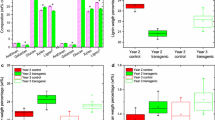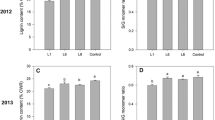Abstract
Modifying plant cell walls by manipulating lignin biosynthesis can improve biofuel yields from lignocellulosic crops. For example, transgenic switchgrass lines with downregulated expression of caffeic acid O-methyltransferase, a lignin biosynthetic enzyme, produce up to 38 % more ethanol than controls. The aim of the present study was to understand cell wall lignification over the second and third growing seasons of COMT-downregulated field-grown switchgrass. COMT gene expression, lignification, and cell wall recalcitrance were assayed for two independent transgenic lines at monthly intervals. Switchgrass rust (Puccinia emaculata) incidence was also tracked across the seasons. Trends in lignification over time differed between the 2 years. In 2012, sampling was initiated in mid-growing season on reproductive-stage plants and there was little variation in the lignin content of all lines (COMT-downregulated and control) over time. COMT-downregulated lines maintained 11–16 % less lignin, 33–40 % lower S/G (syringyl-to-guaiacyl) ratios, and 15–42 % higher sugar release relative to controls for all time points. In 2013, sampling was initiated earlier in the season on elongation-stage plants and the lignin content of all lines steadily increased over time, while sugar release expectedly decreased. S/G ratios increased in non-transgenic control plants as biomass accumulated over the season, while remaining relatively stable across the season in the COMT-downregulated lines. Differences in cell wall chemistry between transgenic and non-transgenic lines were not apparent until plants transitioned to reproductive growth in mid-season, after which the cell walls of COMT-downregulated plants exhibited phenotypes consistent with what was observed in 2012. There were no differences in rust damage between transgenics and controls at any time point. These results provide relevant fundamental insights into the process of lignification in a maturing field-grown biofuel feedstock with downregulated lignin biosynthesis.





Similar content being viewed by others
References
Carroll A, Somerville C (2009) Cellulosic biofuels. Annu Rev Plant Biol 60:165–182
Somerville C, Youngs H, Taylor C, Davis SC, Long SP (2010) Feedstocks for lignocellulosic biofuels. Science 329:790–792
Mitchell R, Vogel KP, Sarath G (2008) Managing and enhancing switchgrass as a bioenergy feedstock. Biofuels Bioprod Biorefin 2(6):530–539
Sarath G, Dien B, Saathoff AJ, Vogel KP, Mitchell RB, Chen H (2011) Ethanol yields and cell wall properties in divergently bred switchgrass genotypes. Bioresour Technol 102:9579–9585
Fu C, Mielenz JR, Xiao X, Ge Y, Hamilton CY, Rodriguez M Jr, Chen F, Foston M, Ragauskas A, Bouton J, Dixon RA, Wang ZY (2011) Genetic manipulation of lignin reduces recalcitrance and improves ethanol production from switchgrass. Proc Natl Acad Sci U S A 108(9):3803–3808
Shen H, He X, Poovaiah CR, Wuddineh WA, Ma J, Mann DG, Wang H, Jackson L, Tang Y, Stewart CN Jr, Chen F, Dixon RA (2012) Functional characterization of the switchgrass (Panicum virgatum L.) R2R3-MYB transcription factor PvMYB4 for improvement of lignocellulosic feedstocks. New Phytol 193(1):121–136
Shen H, Poovaiah CR, Ziebell A, Tschaplinski TJ, Pattathil S, Gjersing E, Engle NL, Katahira R, Pu Y, Sykes R, Chen F, Ragauskas AJ, Mielenz JR, Hahn MG, Davis M, Stewart CN Jr, Dixon RA (2013) Enhanced characteristics of genetically modified switchgrass (Panicum virgatum L.) for high biofuel production. Biotechnol Biofuels 6(1):71
Xu B, Escamilla-Treviño LL, Sathitsuksanoh N, Shen Z, Shen H, Percival Zhang Y-H, Dixon RA, Zhao B (2011) Silencing of 4-coumarate: coenzyme A ligase in switchgrass leads to reduced lignin content and improved fermentable sugar yields for biofuel production. New Phytol 192(3):611–625
Saathoff AJ, Sarath G, Chow EK, Dien BS, Tobias CM (2011) Downregulation of cinnamyl-alcohol dehydrogenase in switchgrass by RNA silencing results in enhanced glucose release after cellulase treatment. PLoS One 6(1):e16416
Pauly M, Keegstra K (2008) Cell-wall carbohydrates and their modification as a resource for biofuels. Plant J 54:559–568
Moura JCMS, Bonine CAV, De Oliveira Fernandes Viana J, Dornelas MC, Mazzafera P (2010) Abiotic and biotic stresses and changes in the lignin content and composition in plants. J Integr Plant Biol 52(4):360–376
Miedes E, Vanholme R, Boerjan W, Molina A (2014) The role of the secondary cell wall in plant resistance to pathogens. Front Plant Sci 5
DeMartini JD, Pattathil S, Miller JS, Li H, Hahn MG, Wyman CE (2013) Investigating plant cell wall components that affect biomass recalcitrance in poplar and switchgrass. Energy Environ Sci 6:898–909
Agbor VB, Cicek N, Sparling R, Berlin A, Levin DB (2011) Biomass pretreatment: fundamentals toward application. Biotechnol Adv 29:675–685
Kumar P, Barrett DM, Delwiche MJ, Stroeve P (2009) Methods for pretreatment of lignocellulosic biomass for efficient hydrolysis and biofuel production. Ind Eng Chem Res 48:3713–3729
Poovaiah CR, Nageswara-Rao M, Soneji JR, Baxter HL, Stewart CN Jr (2014) Altered lignin biosynthesis using biotechnology to improve lignocellulosic biofuel feedstocks. Plant Biotechnol J 12:1163–1173
Wang P, Dudareva N, Morgan JA, Chapple C (2015) Genetic manipulation of lignocellulosic biomass for bioenergy. Curr Opin Chem Biol 29:32–39
Moore KJ, Jung HJG (2001) Lignin and fiber digestion. J Range Manag:420–430
Shen H, Fu C, Xiao X, Ray T, Tang Y, Wang Z, Chen F (2009) Developmental control of lignification in stems of lowland switchgrass variety Alamo and the effects on saccharification efficiency. BioEnergy Res 2:233–245
Hardin CF, Fu C, Hisano H, Xiao X, Shen H, Stewart CN Jr, Parrott W, Dixon RA, Wang ZY (2013) Standardization of switchgrass sample collection for cell wall and biomass trait analysis. BioEnergy Res 6:755–762
Grabber JH (2005) How do lignin composition, structure, and cross-linking affect degradability? A review of cell wall model studies. Crop Sci 45:820–831
MacAdam JW, Grabber JH (2002) Relationship of growth cessation with the formation of diferulate cross-links and p-coumaroylated lignins in tall fescue leaf blades. Planta 215:785–793
Jung HJG (2003) Maize stem tissues: ferulate deposition in developing internode cell walls. Phytochemistry 63:543–549
Chen L, Auh C, Chen F, Cheng XF, Aljoe H, Dixon RA, Wang ZY (2002) Lignin deposition and associated changes in anatomy, enzyme activity, gene expression, and ruminal degradability in stems of tall fescue at different developmental stages. J Agric Food Chem 50:5558–5565
Jung HJ, Casler MD (2006) Maize stem tissues: cell wall concentration and composition during development. Crop Sci 46:1793–1800
Dien BS, Jung HJG, Vogel KP, Casler MD, Lamb JF, Iten L, Mitchell RB, Sarath G (2006) Chemical composition and response to dilute-acid pretreatment and enzymatic saccharification of alfalfa, reed canarygrass, and switchgrass. Biomass Bioenergy 30:880–891
Baxter HL, Mazarei M, Labbe N, Kline LM, Cheng Q, Windham MT, Mann DGJ, Chunxiang F, Ziebell A, Sykes RW, Rodriguez M Jr, Davis MF, Mielenz JR, Dixon RA, Wang Z-Y, Stewart CN Jr (2014) Two-year field analysis of reduced recalcitrance transgenic switchgrass. Plant Biotechnol J 12(7):914–924
Moore KJ, Moser LE, Vogel KP, Waller SS, Johnson BE, Pedersen JF (1991) Describing and quantifying growth stages of perennial forage grasses. Agron J 83:1073–1077
Sykes R, Yung M, Novaes E, Kirst M, Peter G, Davis M (2009) High-throughput screening of plant cell-wall composition using pyrolysis molecular beam mass spectroscopy. In: Mielenz J (ed) Biofuels: methods and protocols, methods in molecular biology. Humana Press, New York, pp 169–183
Decker SR, Carlile M, Selig MJ, Doeppke C, Davis M, Sykes R, Turner G, Ziebell A (2012) Reducing the effect of variable starch levels in biomass recalcitrance screening. In: Himmel M (ed) Biomass conversion: methods and protocols. Springer, New York, pp. 181–195
Selig MJ, Tucker MP, Sykes RW, Reichel KL, Brunecky R, Himmel ME, Davis MF, Decker SF (2010) Biomass recalcitrance screening by integrated high throughput hydrothermal pretreatment and enzymatic saccharification. Ind Biotechnol 6:104–111
Humphreys JM, Hemm MR, Chapple C (1999) New routes for lignin biosynthesis defined by biochemical characterization of recombinant ferulate 5-hydroxylase, a multifunctional cytochrome P450-dependent monooxygenase. Proc Natl Acad Sci U S A 96:10045–10050
Louie GV, Bowman ME, Tu Y, Mouradov A, Spangenberg G, Noel JP (2010) Structure-function analyses of a caffeic acid O-methyltransferase from perennial ryegrass reveal the molecular basis for substrate preference. Plant Cell 22:4114–4127
Osakabe K, Tsao CC, Li L, Popko JL, Umezawa T, Carraway DT, Smeltzer RH, Joshi CP, Chiang VL (1999) Coniferyl aldehyde 5-hydroxylation and methylation direct syringyl lignin biosynthesis in angiosperms. Proc Natl Acad Sci U S A 96:8955–8960
Guo D, Chen F, Inoue K, Blount JW, Dixon RA (2001) Downregulation of caffeic acid 3-O-methyltransferase and caffeoyl CoA 3-O-methyltransferase in transgenic alfalfa: impacts on lignin structure and implications for the biosynthesis of G and S lignin. Plant Cell 13:73–88
Palmer NA, Sattler SE, Saathoff AJ, Funnell D, Pedersen JF, Sarath G (2008) Genetic background impacts soluble and cell wall-bound aromatics in brown midrib mutants of sorghum. Planta 229:115–127
Vignols F, Rigau J, Torres MA, Capellades M, Puigdomènech P (1995) The brown midrib3 (bm3) mutation in maize occurs in the gene encoding caffeic acid O-methyltransferase. Plant Cell 7:407–416
Bhuiyan NH, Selvaraj G, Wei Y, King J (2009) Gene expression profiling and silencing reveal that monolignol biosynthesis plays a critical role in penetration defence in wheat against powdery mildew invasion. J Exp Bot 60:509–521
Le Gall H, Philippe F, Domon JM, Gillet F, Pelloux J, Rayon C (2015) Cell wall metabolism in response to abiotic stress. Plants 4:112–166
Bonawitz ND, Chapple C (2013) Can genetic engineering of lignin deposition be accomplished without an unacceptable yield penalty? Curr Opin Biotechnol 24:336–343
Baxter HL, Poovaiah CR, Yee KL, Mazarei M, Rodriguez M Jr, Thompson OA, Shen H, Turner GB, Decker SR, Sykes RW, Chen F, Davis MF, Mielenz JR, Davison BH, Dixon RA, Stewart CN Jr (2015) Field evaluation of transgenic switchgrass plants overexpressing PvMYB4 for reduced biomass recalcitrance. BioEnergy Res 8:910–921
Jung JH, Vermerris W, Gallo M, Fedenko JR, Erickson JE, Altpeter F (2013) RNA interference suppression of lignin biosynthesis increases fermentable sugar yields for biofuel production from field-grown sugarcane. Plant Biotechnol J 11:709–716
Grabber JH, Ralph J, Lapierre C, Barrière Y (2004) Genetic and molecular basis of grass cell-wall degradability. I. Lignin–cell wall matrix interactions. C R Biol 327:455–465
Ralph J (2010) Hydroxycinnamates in lignification. Phytochem Rev 9:65–83
Lindsey K, Johnson A, Kim P, Jackson S, Labbé N (2013) Monitoring switchgrass composition to optimize harvesting periods for bioenergy and value-added products. Biomass Bioenergy 56:29–37
McLaughlin SB, Kszos LA (2005) Development of switchgrass (Panicum virgatum) as a bioenergy feedstock in the United States. Biomass Bioenergy 28:515–535
Adler PR, Ma S, Boateng AA, Weimer PJ, Jung HJG (2006) Biomass yield and biofuel quality of switchgrass harvested in fall or spring. Agron J 98:1518–1525
Baxter HL, Stewart CN Jr (2013) Effects of altered lignin biosynthesis on phenylpropanoid metabolism and plant stress. Biofuels 4:635–650
Zhao Q, Dixon RA (2014) Altering the cell wall and its impact on plant disease: from forage to bioenergy. Annu Rev Phytopathol 52:69–91
Uppalapati SR, Serba DD, Ishiga Y, Szabo LJ, Mittal S, Bhandari HS, Bouton JH, Mysore KS, Saha MC (2013) Characterization of the rust fungus, Puccinia emaculata, and evaluation of genetic variability for rust resistance in switchgrass populations. Bioenergy Res 6:458–468
Zale J, Freshour L, Agarwal S, Sorochan J, Ownley BH, Gwinn KD, Castlebury LA (2008) First report of rust on switchgrass (Panicum virgatum) caused by Puccinia emaculata in Tennessee. Plant Dis 92:1710
Acknowledgments
We thank Angela Ziebell, Erica Gjersing, Crissa Doeppke, and Melvin Tucker for assistance with the cell wall characterization. We also thank Ben Wolfe, Marcus Laxton, and the UT field staff for general field maintenance and assistance with sample collection, Reggie Millwood for assistance with the USDA APHIS BRS permit regulations, Erika Barton for assistance with sample preparation, and Susan Holladay for assistance with data entry into LIMS. This work was supported by funding from the Southeastern Sun Grant Center and the BioEnergy Science Center. The BioEnergy Science Center is a U.S. Department of Energy Bioenergy Research Center supported by the Office of Biological and Environmental Research in the DOE Office of Science.
Author information
Authors and Affiliations
Corresponding author
Electronic supplementary material
ESM 1
(DOCX 3927 kb)
Rights and permissions
About this article
Cite this article
Baxter, H.L., Mazarei, M., Fu, C. et al. Time Course Field Analysis of COMT-Downregulated Switchgrass: Lignification, Recalcitrance, and Rust Susceptibility. Bioenerg. Res. 9, 1087–1100 (2016). https://doi.org/10.1007/s12155-016-9751-1
Published:
Issue Date:
DOI: https://doi.org/10.1007/s12155-016-9751-1




